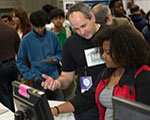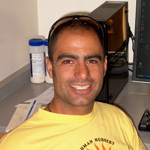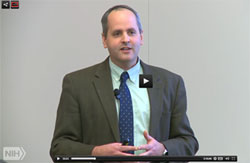 A few weeks ago, 23 NIGMS volunteers and I spent an amazing day with thousands of highly engaged kids, their parents and other science enthusiasts of all ages at the Washington, DC, Convention Center. We were participating in the USA Science & Engineering Festival, the largest STEM event in the nation.
A few weeks ago, 23 NIGMS volunteers and I spent an amazing day with thousands of highly engaged kids, their parents and other science enthusiasts of all ages at the Washington, DC, Convention Center. We were participating in the USA Science & Engineering Festival, the largest STEM event in the nation.
The NIGMS booth was a big hit! Our theme was Cell-e-bration of Science,
with activities that included spelling names with protein letters and a
“selfie station” with science-related props.
Getting young people interested in science is essential to building a vibrant and innovative research enterprise. The Science & Engineering Festival, with more than 365,000 participants, gave us a chance to share our passion for science with thousands of young people. Hopefully, some of the kids we met are now thinking about careers as scientists.
 I encourage you to share your own enthusiasm for science with young people whenever you have the opportunity. Whether you judge a science fair, speak at a career day or have students visit your lab, you put a human face on science and help students see it as an exciting, fulfilling and worthy career choice.
I encourage you to share your own enthusiasm for science with young people whenever you have the opportunity. Whether you judge a science fair, speak at a career day or have students visit your lab, you put a human face on science and help students see it as an exciting, fulfilling and worthy career choice.


 I’m very pleased to announce a new annual lecture to highlight the achievements of some of NIGMS’ early career grantees.
I’m very pleased to announce a new annual lecture to highlight the achievements of some of NIGMS’ early career grantees.

 I’m very pleased to announce that Dorit Zuk will be joining us in early 2016 as the new director of our
I’m very pleased to announce that Dorit Zuk will be joining us in early 2016 as the new director of our 
 I’m very pleased to announce that Alison Gammie will be joining us in the late summer as the new director of our
I’m very pleased to announce that Alison Gammie will be joining us in the late summer as the new director of our